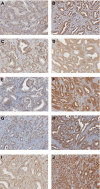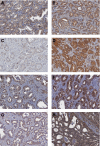Hierarchical clustering of immunohistochemical analysis of the activated ErbB/PI3K/Akt/NF-kappaB signalling pathway and prognostic significance in prostate cancer
- PMID: 20216540
- PMCID: PMC2853085
- DOI: 10.1038/sj.bjc.6605571
Hierarchical clustering of immunohistochemical analysis of the activated ErbB/PI3K/Akt/NF-kappaB signalling pathway and prognostic significance in prostate cancer
Abstract
Background: The PI3K/Akt signalling pathway, induced by epidermal growth factor receptor (EGFR) and Her-2, is involved in the constitutive activation of NF-kappaB in prostate cancer cell lines. In this study, we extended the in vitro observation using an ex vivo model of prostate cancer tissues and assessed the prognostic significance of the PI3K/Ak/NF-kappaB signalling determinants.
Methods: We analysed a prostate cancer tissue microarray of 63 patients for the expression of total and activated EGFR, Her-2 receptors and the signalling molecules PTEN, phospho-PTEN, Akt, phospho-Akt and the NF-kappaB subunit p65. Data were analysed using Spearman's rho test, Kaplan-Meier curves and multivariate Cox regression analysis. In addition, a non-supervised hierarchical clustering analysis was applied to stratify patients according to prognostic groups in terms of risk of recurrence.
Results: The concomitant overexpression of activated EGFR and Her-2 was correlated with the nuclear expression of NF-kappaB. EGFR, phospho-EGFR, phospho-Her-2, ErbB3 and nuclear NF-kappaB were associated with the overall biochemical recurrence (BCR) of patients. The non-supervised hierarchical clustering analysis resulted in the separation of patients into five groups according to BCR.
Conclusions: These results validate the previous in vitro data on ErbB involvement in NF-kappaB activation and shows evidence for a significant role of ErbB/PI3K/Akt/NF-kappaB signalling in the progression of prostate cancer.
Figures





Similar articles
-
Independent role of phosphoinositol-3-kinase (PI3K) and casein kinase II (CK-2) in EGFR and Her-2-mediated constitutive NF-kappaB activation in prostate cancer cells.Prostate. 2005 Dec 1;65(4):306-15. doi: 10.1002/pros.20291. Prostate. 2005. PMID: 16015604
-
Her-2/neu overexpression induces NF-kappaB via a PI3-kinase/Akt pathway involving calpain-mediated degradation of IkappaB-alpha that can be inhibited by the tumor suppressor PTEN.Oncogene. 2001 Mar 15;20(11):1287-99. doi: 10.1038/sj.onc.1204257. Oncogene. 2001. PMID: 11313873
-
[Activation and prognostic significance of AKT, NF-kappaB and STAT3 in breast cancer with lymph node metastasis and estrogen receptor expression].Ai Zheng. 2007 Sep;26(9):929-36. Ai Zheng. 2007. PMID: 17927847 Chinese.
-
The PI3K/AKT pathway in the pathogenesis of prostate cancer.Front Biosci (Landmark Ed). 2016 Jun 1;21(5):1084-91. doi: 10.2741/4443. Front Biosci (Landmark Ed). 2016. PMID: 27100493 Review.
-
Prostate cancer, PI3K, PTEN and prognosis.Clin Sci (Lond). 2017 Feb 1;131(3):197-210. doi: 10.1042/CS20160026. Clin Sci (Lond). 2017. PMID: 28057891 Review.
Cited by
-
The Structure, Functions and Potential Medicinal Effects of Chlorophylls Derived from Microalgae.Mar Drugs. 2024 Jan 27;22(2):65. doi: 10.3390/md22020065. Mar Drugs. 2024. PMID: 38393036 Free PMC article. Review.
-
A Multi-Institutional Validation of Gleason Score Derived from Tissue Microarray Cores.Pathol Oncol Res. 2019 Jul;25(3):979-986. doi: 10.1007/s12253-018-0408-6. Epub 2018 Apr 6. Pathol Oncol Res. 2019. PMID: 29623528
-
Chlorophyllin abrogates canonical Wnt/β-catenin signaling and angiogenesis to inhibit the development of DMBA-induced hamster cheek pouch carcinomas.Cell Oncol (Dordr). 2012 Oct;35(5):385-95. doi: 10.1007/s13402-012-0099-z. Epub 2012 Sep 15. Cell Oncol (Dordr). 2012. PMID: 22983718
-
microRNA-372 Suppresses Migration and Invasion by Targeting p65 in Human Prostate Cancer Cells.DNA Cell Biol. 2016 Dec;35(12):828-835. doi: 10.1089/dna.2015.3186. Epub 2016 Sep 27. DNA Cell Biol. 2016. PMID: 27673408 Free PMC article.
-
Synchronized Targeting of Notch and ERBB Signaling Suppresses Melanoma Tumor Growth through Inhibition of Notch1 and ERBB3.J Invest Dermatol. 2016 Feb;136(2):464-472. doi: 10.1016/j.jid.2015.11.006. Epub 2015 Nov 18. J Invest Dermatol. 2016. PMID: 26967479 Free PMC article.
References
-
- Bedolla R, Prihoda TJ, Kreisberg JI, Malik SN, Krishnegowda NK, Troyer DA, Ghosh PM (2007) Determining risk of biochemical recurrence in prostate cancer by immunohistochemical detection of PTEN expression and Akt activation. Clin Cancer Res 13: 3860–3867 - PubMed
-
- Bublil EM, Yarden Y (2007) The EGF receptor family: spearheading a merger of signaling and therapeutics. Curr Opin Cell Biol 19: 124–134 - PubMed
-
- Cicenas J, Urban P, Kung W, Vuaroqueaux V, Labuhn M, Wight E, Eppenberger U, Eppenberger-Castori S (2006) Phosphorylation of tyrosine 1248-ERBB2 measured by chemiluminescence-linked immunoassay is an independent predictor of poor prognosis in primary breast cancer patients. Eur J Cancer 42: 636–645 - PubMed
-
- Di Lorenzo G, Autorino R, De Laurentiis M, Cindolo L, D’Armiento M, Bianco AR, De Placido S (2004) HER-2/neu receptor in prostate cancer development and progression to androgen independence. Tumori 90: 163–170 - PubMed
-
- Di Lorenzo G, Tortora G, D’Armiento FP, De Rosa G, Staibano S, Autorino R, D’Armiento M, De Laurentiis M, De Placido S, Catalano G, Bianco AR, Ciardiello F (2002) Expression of epidermal growth factor receptor correlates with disease relapse and progression to androgen-independence in human prostate cancer. Clin Cancer Res 8: 3438–3444 - PubMed
Publication types
MeSH terms
Substances
LinkOut - more resources
Full Text Sources
Medical
Research Materials
Miscellaneous

